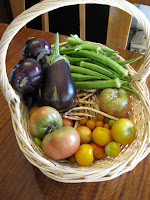I am continually bowled over by how expensive soil is here in Texas. I’m from the Northwest and didn’t realize how much the wood mill and yard debris industries contribute to making cheap sources of compost. I’d have to get three more jobs to afford to buy enough topsoil to even get started on my gardening projects. But considering that I work full time as it is and barely have enough time to play in the dirt, clearly an alternative must be found.
The answer lies in the garbage: compost it.
 |
| Finished compost ready to go to work in the vegetable beds. |
The average household creates an incredible amount of waste and most of it can be utilized to build your own soil. Once you start gardening you will also generate more yard debris. All you need is a composting container or bin and a good pitchfork and you can turn this stuff into black gold.
Compost bins can just be piles in a corner, wire enclosures, wood pallets attached together, a barrel, a stack of cinder blocks, or a bin. My favorite is a three-bin system that I first saw in Kent, Washington. The city was touting composting as a way to reduce waste and had the bin in their demonstration garden. It’s plans come with a lid to help keep rain off and critters out – something we didn’t add when we built the bin while living in Oregon and later here in Texas. Here is a link to the plans that University of Arkansas publishes.
We keep a large, lidded, Rubbermaid container near the sink to hold all our vegetable food waste until filled and taken outside. The only animal products we include are eggshells. Meat and bones are fed to the dog or placed in the garbage. If you have a fire pit you can burn these, but be careful about the smell - burned bone can be unpleasant. The resulting ashes can be tossed into the compost. You can also use shredded paper. Just try to avoid glossy magazines and cellophane. Newspaper can be used also. Some people are uncomfortable using paper because of toxins that may be in the ink (most newspaper is printed with nontoxic soy ink - but check first.) I use the compost made from paper on ornamental plantings and not my vegetable beds just to be sure something didn't sneak in.
Once you get your compost pile built, it does take a little maintenance. Make sure that it doesn’t dry out by soaking it with the hose on occasion. You’ll also need to turn it in order to keep the oxygen flowing to the microbes breaking it down. I turn mine about once a week. You’ll see a lot of advice on how to layer your debris to make sure oxygen flows through the pile. If you plan on turning the pile, you can chuck the advice and just throw plant material in.
Once you get your compost pile built, it does take a little maintenance. Make sure that it doesn’t dry out by soaking it with the hose on occasion. You’ll also need to turn it in order to keep the oxygen flowing to the microbes breaking it down. I turn mine about once a week. You’ll see a lot of advice on how to layer your debris to make sure oxygen flows through the pile. If you plan on turning the pile, you can chuck the advice and just throw plant material in.
It’s amazing how fast your pile will break down. I can get finished compost anywhere between two weeks to a month, depending on what’s in there. The process starts on the left in bin #1 and then gets turned into the next bin until it reaches bin #3. Bin #3's contents get turned onto a screen that fits over my wheelbarrow. The finished compost that falls through goes out to the garden, the larger material that stays on top goes back into bin #1 to go through the process again.




